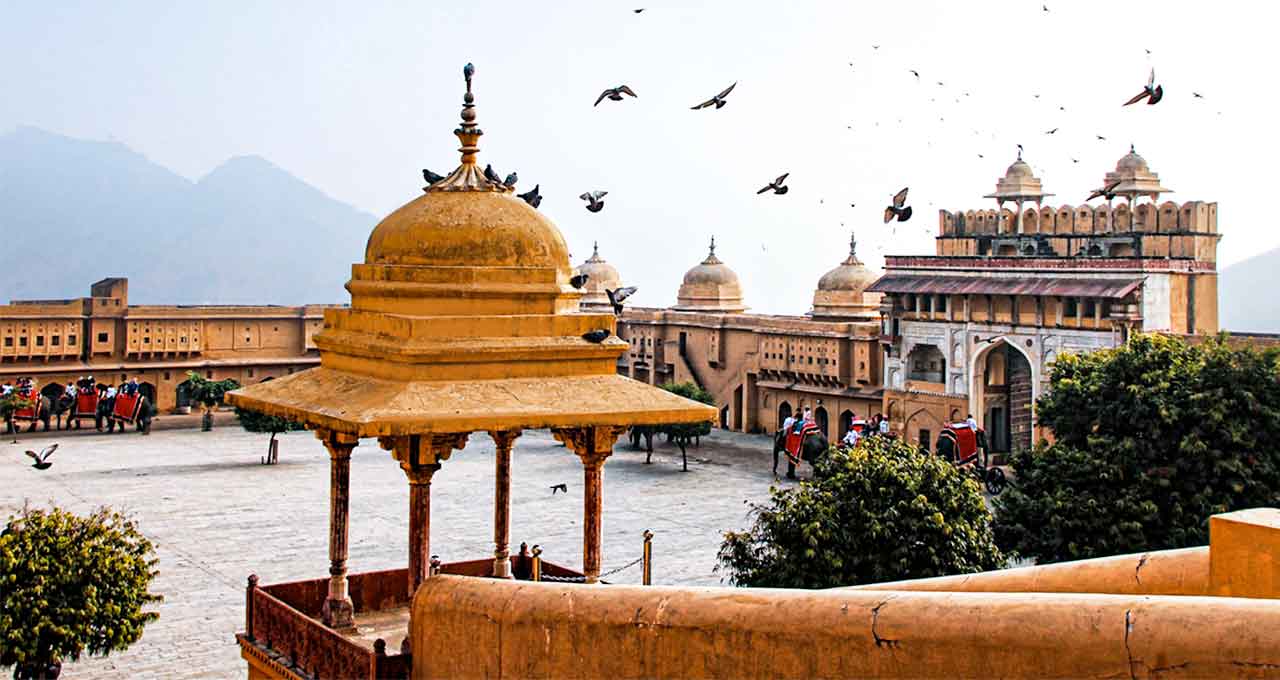
Spotlight Jaipur
The Ultimate Regal Adventure
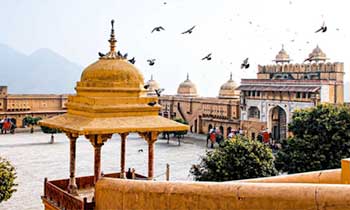
The City Guide Series
Jaipur titillates and stirs the senses endlessly, both, visually and aesthetically. Explore Jaipur's Medieval Forts and Palaces. Get to stay at quaint, historical Rajasthani havelis. Enjoy unique, immersive, mesmerising cultural experiences.
INTRODUCTION
City Guide – Jaipur
History
The construction of Jaipur was started by the Maharaja Jai Singh II, in the year 1727. In 1732 he moved into the spanking new City Palace, located within the spacious confines of his brand new capital city. This was a historic occasion. Since 1592, the ancient Amber Fort had served as the Jaipur State’s seat of power for many generations.
Culture
Today, the city of Jaipur showcases a rich living tapestry of colourful culture. Its vibrant art forms, and dynamic traditions faithfully echo the various stages of its passage through the tumultuous annals of history.
Attractions
Jaipur is home to 3 amazing historic fortresses, of which, the Amber Fort is undoubtedly the patriarch. Other landmarks like the City Palace, the Hawa Mahal, and the Jantar Mantar (Astronomical Observatory) evoke the nostalgia of a colourful and vibrant past.
Location
Jaipur is the capital city of the Indian state of Rajasthan. It is an integral part of the iconic Golden Triangle tourist circuit of North India. Also, a convenient gateway further into Rajasthan, to exciting destinations like Pushkar (for the renowned camel fair in November), Bikaner (and its historic havelis), Jodhpur (the Blue City), Jaisalmer (the heart of the great Thar Desert), and Udaipur (serene city of lakes and palaces).
HISTORY & HIGHLIGHTS
Jaipur – Past and Present
Most big cities around the world started out from humble beginnings, like a strategic river-crossing for regular travellers. Or, a convenient stopping place for travellers along a well-travelled trading route. But, not Jaipur.
Jaipur was a planned city from the very start. It was built according to the timeless principles of vastu shastra, that shaped its growth from concept to completion. Moreover, Jaipur did not lack for residents. It already had a fine complement of eager citizens, ready to move in and take up residence just as soon as it was completed. That’s because Jaipur is a royal city.
Early History of Jaipur
The origins of Jaipur date all the way back to the year 1727. As the former princely Kingdom of Amber, also known as Jaipur State, it was in need of a larger, more spacious city that would serve as its centre of rule. At the time, the Kingdom of Amber was one of the many Rajput kingdoms within the historic region of Rajputana.
The earlier rulers of the erstwhile Jaipur State had ruled from the rugged Amber Fort for many generations, since 1592. Standing on a rugged hilltop, the ancient fort is 11 kilometres away from the present location of Jaipur city. The placement of the fort gave clear visibility for miles around. It was perfect for near foolproof military defence in times of siege. And, that was always a looming threat in those early days.
Dwindling Space at Amber Fort
But, the rapidly growing population meant that the Maharaja Jai Singh II, (1699 to 1743), needed a larger city to house his subjects. A visionary and an able administrator, he was well-versed in the study of mathematics and science. He believed that a systematic town plan along scientific lines would ensure lasting prosperity for his new city.
And so, he planned his dream royal city on the principles of Vastu Shastra – the ancient Vedic science of architecture.
Interesting Highlights
The city of Jaipur throws up many architectural surprises for the visitor. There are superbly decorated havelis with the most opulent traditional designs. Then, there are the three massive ancient fortresses – tribute to a turbulent past. These historical landmarks fire up the imagination of eager visitors. A particularly keen imagination could take you into the stuff of dreams and fable.
The incredibly flavourful local cuisine keeps restaurants and street food vendors busy, alike. There is a vibrant range of colourful, cultural traditions and art forms. The variety of lively performing arts, serve to vivify the experience of wonder and awe.
CITY TOURS
The Fabulous Landmarks of Jaipur
The City Palace
– Stop: 2 hours
– Admission fees are applicable for entry
It was between the years 1727 and 1732 that the Maharaja Jai Singh II made the City Palace his new royal residence. He shifted his court and government from the old capital at the Amber Fort to his glittering new city of Jaipur.
The present generation of the royal family of Jaipur still call it home. It is a huge complex of numerous buildings, temples, pavilions, gardens, courtyards, offices of the royal museum trust, and the Maharaja Sawai Man Singh II Museum.
Not all areas of the complex are open to the general public, since it is still a private home to the royal family. But, eager visitors do get to visit designated public areas and buildings like the City Palace Museum, the Shri Govind Dev Temple, the Chandra Mahal, and the Mubarak Mahal.
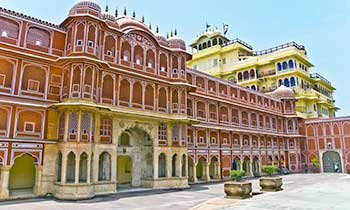
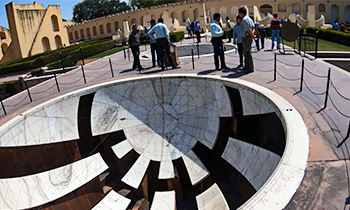
Jantar Mantar – The Astronomical Observatory
– Stop: 60 minutes
– Admission fees are applicable for entry
The Jantar Mantar, at Jaipur is an outdoors observatory with 19 astronomical instruments built in stone by the Maharaja Jai Singh II in 1734. It is home to the world’s largest sundial. It has also been designated as a UNESCO World Heritage Site. The instruments in the observatory are based on the system of Ptolemaic positional astronomy that gives us the ability to map planetary positions with the naked eye.
Maharaja Jai Singh II was a keen and accomplished astronomer. He built a total of 5 observatories around the country, aside from this one in Jaipur. The others are located at Delhi, Ujjain, Mathura, and Varanasi.
The Albert Hall Museum
Renovated in 2008 and currently operating as one of the most advanced museums in the country, the Albert Hall Museum was first opened to the public in the year 1887. The foundation stone for the construction of the museum was laid on 6th February 1876, by the Prince of Wales, Albert Edward, during a state visit to Jaipur at the time. He later became King Edward VII. The museum was officially named after him.
Hawa Mahal – The Palace of Winds
– Stop: 60 minutes
– Admission fees are applicable for entry
One of the most intriguing palaces in the city is the Hawa Mahal or otherwise popularly dubbed the Palace of Winds. It was built in
1799 by Maharaja Sawai Pratap Singh, the grandson of Sawai Jai Singh II, the original founder of Jaipur.
The imposing structure is 5 storeys high, with 953 jharokhas or bay windows in the Rajasthani style, comprising of intricate and exquisitely-carved stone latticework that give it the curious effect of a honeycomb. It has a distinctive red and pink hue that comes from the sturdy sandstone that was predominantly used in its construction.
The latticework feature used in the design of the building served a two-fold purpose. On the one hand, it was primarily to allow the ladies of the royal household to preserve a degree of privacy for viewing of public festivities and celebrations of festivals in the main street below, without otherwise being seen themselves. On the other hand, it was a necessary feature of convenience that would allow for the easy passage and circulation of soothing breezes in order to keep the area pleasant and cool during the scorching heat of summers.
Here’s a Fun Fact
Tourists and eager visitors to Jaipur mostly get to view the Hawa Mahal from outside, at the street level. They usually end up assuming that the delicately carved stone trellis-work of the outer facade is the front portion of the palace. In actuality, it is the rear side of the building. The Hawa Mahal looks inwards onto the inner perimeter of the City Palace, of which it is an integral part.
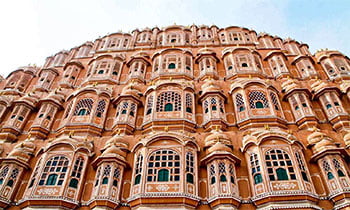
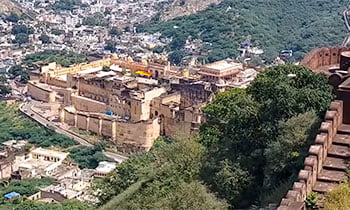
Jal Mahal – The Water Palace on the Man Sagar Lake
– Stop: 30 minutes
Constructed in typical Rajput style of architecture, around the year 1699, Jal Mahal translates to Water Palace. It was built smack in the middle of the Man Sagar Lake. The lake is an artificial lake that was created by the damming of the Dravyavati river in 1610 by Raja Man Singh, and named after him.
Amber Fort
– Stop: 3 hours
Centuries of history resides within the walls of the Amber Fort. It was built by Raja Man Singh I in the year 1592.
Important Notes:
A typical guided tour program of Jaipur would necessarily include the places listed above. These are places that you just cannot afford to miss. In fact, every stop on the designated tour itinerary may be poetically and symbolically likened to each individual heartbeat of this incredible city.
Handy Tip:
Do keep in mind that a half-day tour extends for a maximum of 4 hours within a maximum mileage limit of 40 kilometres. Similarly, the typical full day tour extends for a maximum of 8 hours within a maximum mileage limit of 80 kilometres. Depending on the prevailing prices of fuel, your driver or transporter could bill you for any substantial over-shooting of the trip’s mileage limits.
EXCURSIONS & MORE
The Magnificent, Historical Forts of Jaipur
The Rajputs were a proud race of fierce warriors. They swore by a unique martial code of conduct that often times included a larger than life projection of an adventurous lifestyle and reckless penchant for daredevilry. They zealously guarded their freedom and kingdoms from external enemies – and, oftentimes, from the treacherous covetousness of each other.
Their concern for security for their family and subjects prompted them to focus strongly on fortification of their home estates and palaces. Many of the forts and fortresses that dot the countryside in Rajasthan today, stand as a testimony to the ingenuity and architectural skills they developed locally. Today, many of these historical buildings are in excellent condition, having outlasted centuries of assault by humans and weather, alike. And what’s more than surprising is that they look set to last a few more centuries without too much damage.
Amber Fort – A Rare Glimpse into the Grandeur of Princely Rajputana
The Amber Fort is located atop a rugged, craggy hilltop. It may be reached by taking a pleasantly-swaying, stately, elephant-ride up, or a quicker, jeep-ride to the top. Many also prefer taking an easy 10-minute walk up the paved, winding incline to reach the fort.
While making the ascent, be prepared to be awed by the sight of imposing gates and grand open courtyards. A prominent architectural feature is the rich multitude of intricate carvings on various interior and exterior surfaces that showcase the finest craftsmanship that prevailed in the heyday of the Rajput era.
The magnificent Amber Fort offers a rare glimpse into the opulent lifestyle of the royal courts and princely families of historical Rajputana. Its strategic location and impenetrable defence systems made it a symbol of power and authority. In those days, Rajputana was a collection of independent royal dominions and petty fiefdoms ruled by various Rajput clans.
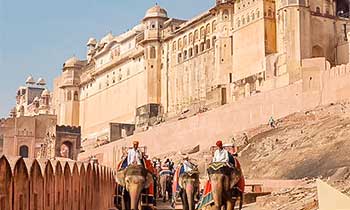
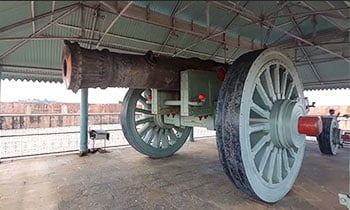
Jaigarh Fort – Military Muscle in Old Rajputana
Perched jauntily on a high, craggy bluff known locally as “Cheel ka Teela” or Eagle Top, the Jaigarh Fort overlooks the nearby Amber Fort and the scenic Maota Lake. It offers a panoramic view of the city of Jaipur, located 11 kilometres away.
Built in 1726 by Jai Singh II, the Jaigarh Fort was essentially an add-on complex to the Amber Fort, in order to supplement protection and security for the older fort complex. Both these forts are inter-connected by underground passages in order to make for seamless connectivity and administrative management. The Jaigarh Fort covers an area that is 3 kilometres lang and 1 kilometre wide. Within its expansive confines lies a large palace complex that include the Laxmi Vilas, Lalit Mandir, Aram Mandir, and the Vilas Mandir.
The fort was equipped with its own weapons foundry for the in-house manufacture of cannons and artillery required for its protection. Today, these facilities function as a museum.
An interesting side note here is that the Jaigarh Fort houses the well-known Jaivana Cannon, that was built on-site. At the time that it was built, the Jaivana Cannon had the distinction of being the world’s largest cannon on wheels. However, it was only ever fired once in its history.
Nahargarh Fort – Royal Retreat for the Ruling Family
The Nahargarh Fort was constructed by Sawai Mansingh (1728-1768), the younger son of Jai Singh II. Along with the ancient Amber Fort, it is also the 3rd fort in Jaipur. It was constructed in 1734, a little after the completion of the new capital of Jaipur city. It stands on the outer edge of the Aravali Hills, overlooking the bustling city of Jaipur below.
It was initially built to be a place of retreat in case of attack upon the city. Later, though, it was used as a holiday retreat for the royal family and their entourage to escape the hot and sultry days of summer. The elevated location and open surroundings shaded by the dense vegetation of deciduous forest, made for a salubrious getaway from the heat that enveloped the city below.
Newer constructions and additions continued in the fort in 1868, and again between 1883-92. This was when the palatial Madhavendra Bhawan was added to the complex by the next king, Sawai Madho Singh (1862-1922). The imposing building was replete with ultra-luxurious suites and interiors decorated with delicate frescoes for the queens of Jaipur. It also had a luxurious master suite for the king, himself.
Royal Gaitor Tumbas – The Royal Cenotaphs
The name Gaitor is supposedly an abbreviation or corruption of the term: Gaye ka Thor, in the local Marwari dialect that translates as “resting place of the departed souls”.
Also known as the Royal Cenotaphs, the Royal Gaitor Tumbas serves as a cremation ground and memorial site for the male members of the Jaipur Royal Family. It is located in a little secluded hollow between the small hills that lie below the Nahargarh Fort.
The Royal Gaitor Tumbas was never a “must do” on Jaipur’s sightseeing circuit previously; probably because of the sombre nature of the site. However, the site has gained increasing footfalls in recent years on account of the distinctive architecture of the memorial structures within.
The Royal Cenotaphs are mostly built as open pavilions with ornate domes supported by intricately sculpted pillars. The style and construction of each cenotaph is said to reflect the personality and preferences of the particular maharaja who was cremated therein.
Handy Tip:
Excursions and visits to nearby places in and around Jaipur that are not included in the regular city tour itinerary, can usually be arranged as separate tours. They also need to be paid for separately. You should pre-arrange these visits and fix additional prices in advance with your tour operator or transporter, as the case may be.
SHOPPING
Ultimate Shopping Places You Cannot Afford to Miss in Jaipur
Can any holiday ever be complete without a glorious shopping spree? Thank you for asking! We agree, too, that Jaipur is the ultimate shoppers’ paradise that never fails to impress.
Shopping destinations range from the historical bazars of Jaipur to glitzy, modern malls. What characterises them all are the crowds of entranced shoppers earnestly engrossed in prospecting and bargaining for that golden deal that will forever serve to remind them of their best holiday.
Some of the finest shopping in Jaipur, though, is to be had within the historic confines of the old walled city. A series of busy, bustling markets are strategically and conveniently located within the two town squares known locally as Badi Chaupar and Chhoti Chaupar.
Chandpol Bazaar
Located in the area known as the Khazanewalon ka Rasta, this is one of Jaipur’s most traditional markets, known especially for souvenirs, handicrafts, and stone and wooden sculptures. You can even shop for turbans, carpets, and more.
Johri Bazaar
This market has on offer one of the largest collections of gems and precious stones in India. It is also a popular market for antiques and a variety of local handicrafts.
Kishanpol Bazar
On offer here are textile products, carved wooden souvenirs, and a variety of the local handicrafts of Rajasthan. But, the biggest draw here are the textile products at superbly reasonable prices.
Sireh Deori Bazaar
Set just across from the Hawa Mahal, this bazar will set the tone for your Jaipur shopping adventure. The range of products on offer go from soft, light Jaipur-style quilts, to puppets, leather shoes, tasteful knick-knacks, and colourful textiles.
Tripolia Bazaar
Famous for a wide range of lac jewellery and amazing varieties of bangles and textiles. The exquisite range of Bandini tie and dye fabrics will leave you dizzy. Other exotic items include delicately intricate embroidery work, a dazzling array of brass ware, designer carpets and a lot more.